The Lay of the Land
A research seminar taught by Associate Professor of History Amy Offner delves into the complex history of Latin American and Latinx farmworkers in the United States.

A young woman United Farmworker organizer petitioning in a celery field to verify demand for union representation vote, Watsonville, CA, 1972. (Image: Bob Fitch Photography Archive, Department of Special Collections, Stanford University Library)
Amy Offner, an associate professor in the Department of History, has regularly given a lecture on the farmworker movement as part of her course about capitalism, socialism, and social movements in the Americas. When the COVID pandemic hit, her students wanted to learn more.
“They really wanted to study this history,” says Offner, “having just lived through the largest wave of social protest in half a century and having become acutely aware of ‘essential workers,’ including the farmworkers who were producing the food they ate.”
In response, Offner offered a research seminar that fall that invited students to explore the history of farmworkers in the U.S. during the 20th century. Among other topics, the course—which she is teaching again this semester—looks at the experiences of farmworkers from Latin America, as well as Latinx workers, and the role of U.S. imperial and immigration policies in their lives.

United Farmworker picketers appeal to people packing grapes, Fresno County, CA, 1972. (Image: Bob Fitch Photography Archive, Department of Special Collections, Stanford University Library)
Latin American history has long been an area of special focus for Offner, who notes that in the western and southwestern parts of the U.S., Mexicans were engaged in agriculture before those regions even became part of the country. With the U.S.-Mexican War of the 1840s, the border moved south, and those farmworkers became U.S. citizens and Mexican Americans.
“One of the first things we learn in studying the history of farmworkers is that there is no simple, two-sided story about Latin Americans and the United States,” says Offner. “If we start simply by looking at people of Mexican ancestry in the 20th century, we find a wide variety who wound up in the United States at different times, under very different circumstances, and who had divergent relationships to U.S. and Mexican societies—from Mexican American citizens of the United States to immigrants with different legal statuses and ethnic origins.”
Those distinctions, she says, could drive wedges between these workers socially and politically. “The history of farmworker organizing in the United States has been as much about people originally from Mexico deciding how to relate to each other as it has been about any generic relationship between Latin Americans and the United States.”
The course title, Huelga (“strike” in Spanish), invokes the United Farm Workers (UFW) union, which was founded by Mexican American and Filipino workers in California during the 1960s. Three decades earlier, the federal government had recognized the right of most workers in the private sector to organize unions, says Offner, but federal policies contained systematic exclusions—labor law and social insurance programs like Social Security, for example, did not cover agricultural or domestic workers.
During World War II, when military service and war production work generated a labor shortage in the fields, the federal government responded by creating guestworker programs that brought migrants from Mexico and the Caribbean into the country temporarily to work. At the same time, says Offner, they were denied a host of political and social rights. “Guestworkers had no right to stay permanently in the country, no path to citizenship, and no right to quit or seek a new job,” she says.
One of the first things we learn in studying the history of farmworkers is that there is no simple, two-sided story about Latin Americans and the United States.
These issues raised questions that historians—and students in Offner’s class—continue to explore. Offner provides some examples: How did guestworkers assert themselves in the face of exploitation, racism, and abuse? How did their migration to the United States affect households, communities, and strategies of economic development in Mexico and the Caribbean? How did farmworkers attempt to organize in the U.S. during the postwar decades when many of them could be deported for trying to unionize or strike?
Operating outside the bounds of federal labor law during the 1970s, the UFW won state-level legislation in California that provided farmworkers with the right to organize and engage in collective bargaining. Offner says this marked a new era in the history of U.S. labor, and its implications have been studied extensively. “It has inspired historians, as well as students in this class, to ask new questions,” she says. “To what extent is the UFW’s history representative of experiences of farmworkers and unions across the United States? What stories remain to be told?”


